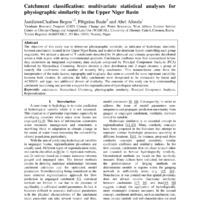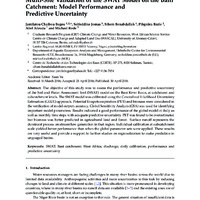Recherche
3 items
Catchment classification: multivariate statistical analyses for physiographic similarity in the upper niger basin
The objective of this study was to determine physiographic similarity, as indicator of hydrologic similarity between catchments located in the Upper Niger Basin, and to derive the dominant factors controlling each group singularity. We utilized a dataset of 9 catchments described by 16 physical and climatic properties distributed across a wide region with strong environmental gradients. Catchments attributes were first standardized before they underwent an integrated exploratory data analysis composed by Principal Component Analysis (PCA) followed by Hierarchical Clustering. Results showed a clear distribution into 2 major clusters: a group of easterly flat catchments and another of westerly hilly catchments. This nomenclature came from the interpretation of the main factors, topography and longitude, that seem to control the most important variability between both clusters. In addition, the hilly catchments were designated to be dominated by forest and ACRISOL soil type, two additional drivers of similarity. The outcome of this study can help understanding catchment functioning and provide a support for regionalization of hydrological information.
Identification of the swat model parameters on the bani catchment (west africa) under limited data condition
Results showed that the model performance can be judged as very good (Moriasi et al., 2007) especially considering limited data condition and high climate, land use and soil type variabilities in the studied basin (Figure 1). Prediction uncertainty is acceptable: most of the observed data (around 80& ) are bracketed by the 95PPU within an acceptable width (R-factor < 1). However, model is characterized by more prediction uncertainties during high flows (Figure 2). The most sensitive parameters are mostly related to surface runoff reflecting the dominance of this process on the streamflow generation (Table 1).
Multi-site validation of the swat model on the bani catchment: model performance and predictive uncertainty
The objective of this study was to assess the performance and predictive uncertainty of the Soil and Water Assessment Tool (SWAT) model on the Bani River Basin, at catchment and subcatchment levels. The SWAT model was calibrated using the Generalized Likelihood Uncertainty Estimation (GLUE) approach. Potential Evapotranspiration (PET) and biomass were considered in theverificationofmodeloutputsaccuracy. GlobalSensitivityAnalysis(GSA)wasusedforidentifying important model parameters. Results indicated a good performance of the global model at daily as well as monthly time steps with adequate predictive uncertainty. PET was found to be overestimated but biomass was better predicted in agricultural land and forest. Surface runoff represents the dominant process on streamflow generation in that region. Individual calibration at subcatchment scale yielded better performance than when the global parameter sets were applied. These results are very useful and provide a support to further studies on regionalization to make prediction in ungauged basins.


